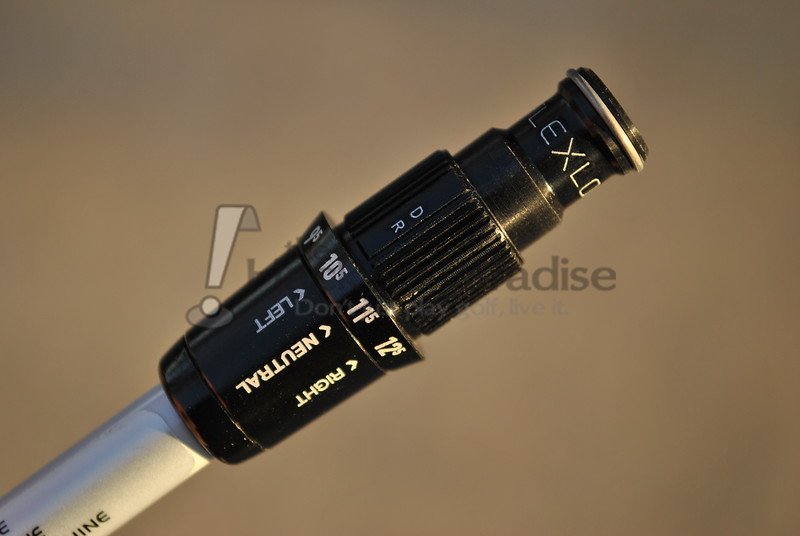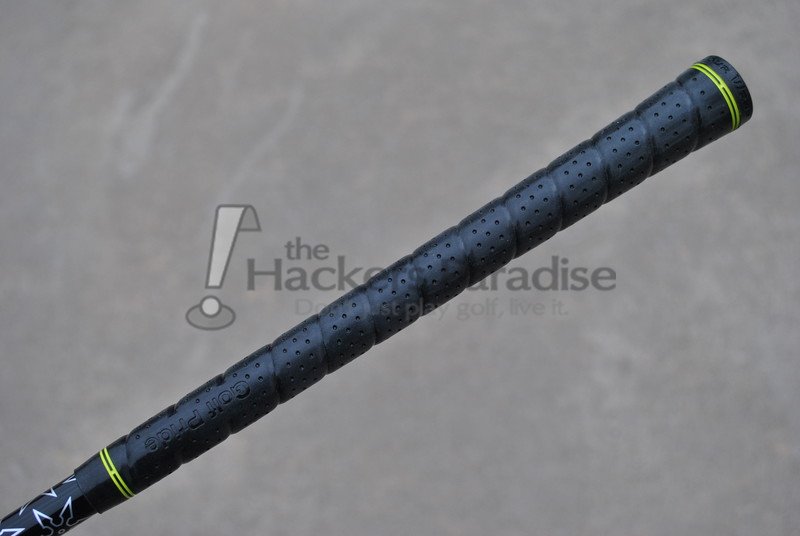Nike Vapor Pro Driver Review
Nike has clearly gone all-in on their marketing for athletes – some like that, and some don’t. Some construe it as alienating a portion of amateurs, but lost in that is their recent push towards emphasizing that what their athletes play is exactly what is available to their consumers. For the new Vapor lineup of drivers from Nike, there is no better example of this than the Vapor Pro. This is a head added to the lineup only because Rory took it into play at the Ryder Cup and is seeing so much success with it. Originally the Vapor line was set to consist of the Flex and Speed drivers, but now their top athlete’s preferred design has been dropped right into the middle to round out the line in terms of spin and launch.
For this review THP was able to spend time working with and breaking down the Nike Vapor Pro driver paired with the stock 2015 Diamana S+ 60 shaft.
Information on the Vapor Pro driver from Nike Golf:
With a pear-shaped head, preferred by Rory McIlroy, the Nike Vapor Pro driver head utilizes a Covert Cavity Back, Compression Channel, and NexCOR face to unleash explosive distance and tour level launch for piercing trajectory.
Specifications and Options:
| RH LOFTS | LH LOFTS | CC | SWING-WEIGHT | LENGTH |
| 8.5° to 12.5° via FlexLoft | 8.5° to 12.5° via FlexLoft | 460cc | D3 | 45.5” |
Stock Shaft Options:
- 2015 Mitsubishi Diamana S+ 60 (R, S, X)
Additional Custom Shaft Offerings at No Upcharge:
- 2015 Mitsubishi Diamana D+
- 2015 Mitsubishi Fubuki Z
- 2015 Mitsubishi Fubuki ZT
Technology Spotlight:
- Covert Cavity Back Technology
Speculation by some has been how long will Nike stick with the Covert Cavity Back technology in their drivers which started with the original Covert. If the Vapor line is any inclination then it will continue to be a key technological focal point. Although it has evolved considerably in size, shape, and structure from its origin to the present, the premise and tech remains the same.
The goal of the Cavity Back in the driver is that by removing mass from that section they can have a more forward weight in the head which will allow for keeping a more constant MOI across the club while also reducing the gear effect and helping the resistance to twisting. Basically the simple breakdown is fewer changes to the overall launch across the face of the driver within the entire Vapor driver line, which should help decrease the often accentuated hook and cut flights on misses toward the extremities of the face.
- Fly-Beams
A new addition to the Nike drivers is what they are calling “Fly-Beams”. While not the greatest name in the world, they actually serve as a pretty significant change design-wise. Basically, Nike compares these to I-beams in construction that shore up stability. Here the beams are visible in the cavity and actually run all the way through the heads and to the face.
The purpose of such an addition is to increase stability and help keep more of the flex of the driver in the face while limiting loss throughout the rest of the head. Keeping as much of the energy in the face as possible should mean more speed off the face and more speed of course means more distance.
- Compression Channel
When Nike released the first Covert driver with its Covert Cavity Back Technology in it they introduced something new and radical but also moved away from arguably one of their most successful design features within their woods, the Compression Channel. It was often discussed that they didn’t believe it would be effective with the Covert Cavity Back setup, but at the request of Tiger Woods they took a look at it again for the Vapor lineup of drivers.
In order to get the compression channel to have an effect and keep within the set CT rules, a variable depth was utilized. The channel is shallower at the center of clubface as well as beveled in order to keep from exceeding max CT there, while at the heel and toe extremities the new channel features a significant depth increase to maximize the CT in relation to regions where misses occur most often on a club-face. As Nike describes it, the channel actually flexes both ways (compresses and opens) depending on where impact is made on the face.
- FlexLoft 2 Adapter
In the world of adjustable clubs Nike’s FlexLoft adapter continues to be one of the most effective and easy to dial in out there. For the Vapor line Nike has developed a slight tweak to the adapter and now refer to it as FlexLoft 2.
The only change to the adapter is in materials within the structure that have allowed the savings of 5g of total weight. The 5g is a 30% savings compared to the original FlexLoft and has led to Nike now applying lighter head-weights in the Vapor Line which will allow easier swing weighting while maintaining the same durability and 15 loft settings. It needs to be noted also that the original FlexLoft adapter does still work within all three heads in the Vapor line, typically there will simply be a swing weight change around 1.5 points (depending on the shaft used of course).
Aesthetics:
First things first, the name of the color is Volt, and it absolutely will be hit and miss with golfers across the spectrum. That said, the departure from the “Tiger Red” which we have known Nike to follow for years now was a needed one for a variety of reasons, but no one ever expected Volt. As Nike says it, they feel they are known historically for two colors, orange (think shoe boxes), and Volt (through pretty much all of their other sports lines), but that still doesn’t take away from the initial shock of the color.
The head features the Volt color in two main areas: first the Covert Cavity and secondly the Nike Swoosh located towards the shaft/heel of the crown at address. As for the cavity, though it cannot be seen at address, it still isn’t for everyone despite its positive size evolutions. With the single Swoosh, it has been an area of contestation for some as being distracting since the original Covert, but it flows well with head providing a nice splash of color for this reviewer.
The head is rounded out by deep metallic finish somewhere between black and grey. On the crown is a fading grey/white triangular cross-hatch pattern on the rear that is pleasantly not noticeable from address. Worth mentioning also is the lack of an alignment aid on any of the three driver models – again, a personal preference issue. The sole and face are rounded out in a black PVD which lends to a really stark contrast to the Volt while also being quite aggressive looking.
It has to be mentioned also that the stock 2G Wrap grip chosen by Nike leaves a much to be desired as it has been noted many times that it really struggles in some climates, especially humid one. Yes, it is an easy fix, but it would be nice to see Nike move to a better stock grip given the price of the driver itself.
The head itself is a 460cc design, but is done in such a manner that at address most will not feel that it is anywhere near that large. The Vapor Pro features a deeper face and has a more dramatic slope from the face to the rear which hides much of the overall mass. Additionally, the head has a more rounded toe that was actually a design request from Rory McIlroy. All of this combined leads to a very classic looking “pear” shape, which at its root (Volt excluded) should appeal to a large number of golfers who don’t care for a more bulbous and rounded head style.
Overall Performance:
- Sound/Feel:
One area where the Covert and Covert 2.0 were significantly lacking was in sound/feel. The Covert Cavity Back did not lend itself to being one of the more acoustically friendly heads in the opinion of this reviewer. Thankfully, with the Vapor line as a whole and the Vapor Pro in particular Nike has finally gotten the acoustics right. The sensation at impact is a solid one, as is the sound put off from impact. There is no resonance, metallic tendency, or reverberating echo in this head. Across the face there are changes in the audible and tactile feedback that should be enough to please most users. While one might not describe the impact sensation as “hot”, there is also no “deadness” to it. The ball really doesn’t give the feel of jumping nor lagging behind. This is easily the best sound/feel combo we have seen from Nike to this point. Though some amateurs could care less about this, the sound of a head can be a turnoff for many others, but neither group will take issue with the Vapor Pro here.
Ball-Flight/Trajectory:
The Vapor Pro driver fits firmly in the middle of the Vapor lineup between the Flex and Speed in terms of spin and launch. Compared to the Covert 2.0 Tour, Nike has moved the CG lower in the head (2.3%) as well as closer to the face (5.8%), and while that may not seem like much one must keep in mind that club design is a game of millimeters and grams. Time spent testing the Vapor Pro repeatedly showed launch angles bordering on mid and it was one of the lower spinning heads this reviewer has spent time with this year. The pairing with the new Diamana S+ is a very balanced setup and the ball flight worked its way to apex and down on its ascent in a repeatable manner regardless of the loft setting being utilized. Though it will be touched on more in the next category, misses high on the face resulted in the expected increase in launch, just as lower on the face resulted in a lower flight. It should be noted though that the response lower on the face was improved a good deal for this reviewer compared to the Covert and Covert 2.0 drivers. Some credit undoubtedly has to go to the compression channel’s return. This head should certainly appeal most to users who tend to naturally generate a good bit of spin and want to decrease it while maintaining a more mid-range launch angle. Understandably, workability is a real concern in a driver for a segment of golfers out there, and those looking for that will want to gravitate to the Vapor Pro or the Flex rather than the Speed.
- Forgiveness/Distance:
This is the area of most improvement for the new Vapor line compared to the Covert 1.0 and the Covert 2.0. During testing, this reviewer found that the Vapor Pro driver had significantly better ball-speed retention on misses than the 2.0 Tour model. Speeds were 3-4 MPH better in retention on those misses compared to the same misses on the 2.0 Tour (with the same shaft, length, and swing weight setup) in the case of this particular users swing. Much of this has to come back to the addition of the Fly-Beams and Compression Channel within the design, because the stability of the head on misses is exponentially better feeling than that of the two previous Nike releases. The same can actually be said of the entire Vapor driver line. Overall, low misses saw the most loss of height/distance, while high on the face maintained a good distance considering the natural spin increase on that miss (though marginal compare to some heads tested this year). Lateral misses were the biggest surprise given the spin and launch nature of the head and that again has to come back in a large way to the stability of the head there and reduction of the overall gear effect. Ball speeds have been talked about by some on the internet as lagging behind some other heads, but for this reviewer center strikes were among the best tested. Misses showed drop offs, but not as drastic as in the past
In terms of distance, on center/sweet-spot strikes the Vapor Pro is one of the longer heads this reviewer has spent time with this year. However, it really needs to be mentioned here that it will all come back to fitting the user’s needs in terms of spin. It’s a lower spinner and as such natural low spin players will probably struggle with it for distance. On lateral misses the Vapor Pro showed improved distances from its predecessors and the lack of shudder or twisting is big here in keeping distance on those common misses. For those who fit into the lower spinning and more mid launching driver setup areas, the Vapor Pro is certainly worth a look as it meshes distance and forgiveness better than we have seen in the past from Nike.
Parting Thoughts:
There is no denying that the Vapor lineup of clubs has caused a lot of discussion and most are based around the aesthetics of the line. With that said though, it certainly seems that where performance is concerned Nike has begun to turn a corner into producing a more well-rounded metalwood design while keeping that Covert Cavity Back look that is so easily recognizable by so many as “being” Nike. The Vapor Pro in particular provides that middle ground head in a lineup with ambitions of having something to fit everyone. Naturally, at lower spin and more of a low-mid launcher, it will fit a more finite section of golfers, but it does fit one different than its brethren the Vapor Flex and Vapor Speed.
The Nike Vapor Pro driver comes with an MSRP of $399.00, more info on it and the rest of the Vapor line can be found at www.NikeGolf.com.






















Great review James, I’m not a big fan of the volt color choice but it sounds like it’s backed up by some great technology and the results so far prove it.
Well done!
Very thorough review, James. I have never really spent much time with Nike drivers, but this one sounds promising in terms of distance and forgiveness.
Great work James, Looks like Nike has done a great job with their latest set of Vapor products and this pro driver fits right in. That Volt color sure does pop!
Great review James. I know you were really excited for this one. I had one of these for a short period of time but it just was too low spin for me. But in hand, it is an absolutely gorgeous club and will be a great performer for anyone looking for low spin which seems to be more and more people these days.
Great work on this one James, Nike has a great lineup this year and I appreciate you educating us on it.
Great job on a very detailed review James. I for one like the volt color and the looks.
A great review James. I’ve personally never hit any of the Nike drivers but am interested in this one for sure. Very comprehensive as always.
ALL of Nike’s offerings up to and including the present resemble bargain basement clubs, with their garish colours and shiny finishes, and for this reason alone I could never envision buying any of their gear.
This is a freaking great head – at a fitting yesterday I gained 20 yards with an optimized shaft pairing (Matrix Velox). Far from a bargain basement club, and it looks outstanding at address.
Strongly considering picking one of these up.
I briefly speed read your review of the Vipor range but as far as I can see you didn’t say which model is suitable for a player with a slowish swing. I am 70+ age!
regards
R.T.Sherwin